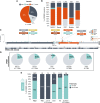Diverse ERBB2/ERBB3 Activating Alterations and Coalterations Have Implications for HER2/3-Targeted Therapies across Solid Tumors
- PMID: 40178042
- PMCID: PMC12022956
- DOI: 10.1158/2767-9764.CRC-24-0620
Diverse ERBB2/ERBB3 Activating Alterations and Coalterations Have Implications for HER2/3-Targeted Therapies across Solid Tumors
Abstract
Abstract: Although ERBB2 (HER2) is an established oncogenic driver and therapeutic biomarker in several cancers, current drug approvals do not reflect the diverse spectrum of activating alterations across indications in which HER2-targeted therapies may yield clinical benefit. In most cancer types, HER2 status is defined by HER2 overexpression/amplification assessed by IHC and FISH, which do not provide genomic context. We sought to define the pan-tumor landscape of activating ERBB2 and ERBB3 genomic alterations detected by comprehensive genomic profiling (CGP). We queried institutional databases of solid tumor CGP, including 429,666 patients who underwent Foundation Medicine testing and 83,332 patients whose tumors were profiled using Memorial Sloan Kettering Integrated Mutation Profiling of Actionable Cancer Targets (MSK-IMPACT). We identified activating ERBB2 and ERBB3 alterations across solid tumor types, including many off-label for current HER2 drug approvals. Whereas non–small cell lung cancer represented the highest proportion of ERBB2-mutated (i.e., single-nucleotide variants and short insertions/deletions) cancers (19.0%), breast, colorectal, bladder, and gastroesophageal cancers combined accounted for 50.4% of ERBB2-mutated tumors. Within non–small cell lung cancer, 26% of activating mutations were not included in clinical trials that led to approval of the antibody–drug conjugate trastuzumab deruxtecan. We also present three clinical cases demonstrating clinical benefit from off-label use of HER2-targeted therapies. We identified substantial populations of patients with diverse ERBB2/ERBB3 activating alterations, which represent unmet therapeutic needs. We demonstrate that CGP provides additional genomic information, inclusive of ERBB2 amplification and mutation status together with potential resistance/response-modifying co-alterations, allowing for more nuanced HER2 status interpretation than is possible with IHC/FISH alone.
Significance: CGP provides genomic context for HER2 status beyond the information provided by IHC and FISH, including detection of ERBB2 mutations and co-alterations that may suggest sensitivity/resistance to HER2-directed therapies, and is therefore crucial for guiding treatment choice and understanding individual patient response.
©2025 The Authors; Published by the American Association for Cancer Research.
Conflict of interest statement
A. Drilon reports personal fees from Honoraria/Advisory Boards and Equity and other support from Associated Research to Institution and Food/Beverage during the conduct of the study, as well as personal fees from Royalties and CME Honoraria outside the submitted work; in addition, A. Drilon has a patent to Selpercatinib-Osimertinib (US 18/041,617, pending) pending and reports the following: Honoraria/Advisory Board: 14ner/Elevation Oncology, Amgen, Anheart Therapeutics, Abbvie, ArcherDX, AstraZeneca, Bayer, Beigene, BergenBio, Blueprint Medicines, Boundless Bio, Bristol Myers Squibb, Chugai Pharmaceutical, EcoR1, EMD Serono, Entos, Exelixis, Helsinn, Hengrui Therapeutics, Ignyta/Genentech/Roche, Innocare, Janssen, Loxo/Lilly, Merus, Monopteros, MonteRosa, Novartis, Nuvalent, Pfizer, Prelude, Regeneron, Repare RX, Takeda/Ariad/Millenium, Treeline Bio, TP Therapeutics, Tyra Biosciences, Verastem, and Zymeworks; Associated Research to Institution: Foundation Medicine, Teva, Taiho, GlaxSmithKlein, PharmaMar Equity: mBrace, and Treeline; Copyright: Selpercatinib-Osimertinib (US 18/041,617, pending); Royalties: Wolters Kluwer, UpToDate, Food/Beverage: Boehringer Ingelheim, Merck, and Puma; and CME Honoraria: Answers in CME, Applied Pharmaceutical Science, Inc, AXIS, Clinical Care Options, Doc Congress, EPG Health, Harborside Nexus, I3 Health, Imedex, Liberum, Medendi, Medscape, Med Learning, MedTalks, MJH Life Sciences, MORE Health, Ology, OncLive, Paradigm, Peerview Institute, PeerVoice, Physicians Education Resources, Projects in Knowledge, Resources, Remedica Ltd , Research to Practice, RV More, Springer Healthcare, Targeted Oncology, TouchIME, and WebMD. A.M. Heilmann reports other support from Foundation Medicine, Inc. and Roche outside the submitted work. J.M. Allen is an employee and stock holder of Foundation Medicine. A.B. Schrock reports personal fees from Foundation Medicine and other support from Roche during the conduct of the study. R.B. Keller-Evans reports other support from Foundation Medicine, Inc. and Foundation Medicine, Inc. during the conduct of the study and outside the submitted work. B.T. Li reports nonfinancial support from Foundation Medicine during the conduct of the study and grants from Amgen, AstraZeneca, Boehringer Ingelheim, Bolt Biotherapeutics, Daiichi Sankyo, Genentech, Nuvalent, and Revolution Medicines outside the submitted work; in addition, B.T. Li has a patent to US62/685,057, US62/514,661, US63/424,813 issued and is currently an employee and has stock at AstraZeneca. The submitted work was performed at his previous institution, Memorial Sloan Kettering Cancer Center. No disclosures were reported by the other authors.
Figures





References
-
- Baselga J, Swain SM. Novel anticancer targets: revisiting ERBB2 and discovering ERBB3. Nat Rev Cancer 2009;9:463–75. - PubMed
-
- Marra A, Chandarlapaty S, Modi S. Management of patients with advanced-stage HER2-positive breast cancer: current evidence and future perspectives. Nat Rev Clin Oncol 2024;21:185–202. - PubMed
-
- Strickler JH, Cercek A, Siena S, André T, Ng K, Van Cutsem E, et al. . Tucatinib plus trastuzumab for chemotherapy-refractory, HER2-positive, RAS wild-type unresectable or metastatic colorectal cancer (MOUNTAINEER): a multicentre, open-label, phase 2 study. Lancet Oncol 2023;24:496–508. - PubMed
MeSH terms
Substances
Grants and funding
LinkOut - more resources
Full Text Sources
Medical
Research Materials
Miscellaneous

